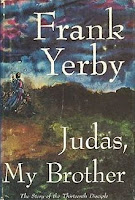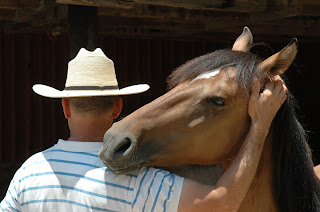Book Challenge Last Days -- 19 & 20
Day 19/20 – Stranger in a Strange Land, Robert Heinlein -- 1961
Lately, I have been struggling to work my way through a Mars trilogy by Kim Stanley Robinson. It essentially documents the establishment and evolution of a new civilization, perhaps even a branch of humans, as the first Mars settlers seek to live on the planet and ultimately become independent of Earth.Not quite the opposite, Mars-born Mike Smith is the son of two Earth-born Mars settlers, the only survivor of that expedition. When he returns to Earth, while still essentially a “human,” he recognizes nothing about Earth society and culture. The third world war has occurred, and a new religion has been established. He develops a relationship with a nurse he meets while adjusting to Earth’s environment and gravity; she fears for his life and they both escape Bethesda Medical Center. He develops psychic abilities and super intelligence while investigating Earth culture, especially its religions. He is relatively emotionless and has never laughed, but when he finally learns to laugh, he thinks he understands humans. He goes on to found his own religion, which looks surprisingly like the hippie culture of the late 60s, where members are instructed in psychic ability and the Martian language so they can truly “grok,” or comprehend/love all things.
As an impressionable high school student – I probably read this around 16 or 17 – I loved the ideas about love and sex and probably read this more as a rebellion than a genuine interest. The idea of religion, old or new, however, was not attractive to me, so its impression was piecemeal rather than inspirational. It is said that Heinlein wrote the book in two stages, and that point is noticeable in the book, where Michael’s growth and “grokking” humankind ends and the religion (and a lot of sermonizing) begins.
His editors required that he cut his manuscript from 220,000 words to 160,000. Three years after Heinlein died in 1988, his widow released the longer version, which Heinlein preferred, but I have not read. The Library of Congress named it one of 88 “Books that Shaped America.” And it probably deserves that, if only for introducing the word “grok” into the English language (it’s in the Oxford English Dictionary) and concepts such as Fair Witness and Water Brother (more common in the 60s than now).
Day 20/20 of the childhood book challenge
On this last day of the challenge to discuss 10, then 20 books of my childhood, I thought I would offer short glimpses of a hodge-podge of a half dozen books that didn’t make the first or second cut, largely because I was a voracious reader when I was someone with fewresponsibilities and a tendency to be a loner. There are many more.
First up is Big Red, Jim Kjelgaard (1945) – the first in a series of books about Irish setters, Big Red is Danny’s constant companion. They have many adventures in the wooded Pennsylvania area much like the area Kjelgaard grew up in. Their nemesis is a savage bear named Old Majesty, king of the wilderness. I read Outlaw Red and Irish Red, too. I was so infatuated with Irish setters in print, that I decided (this was some time in elementary school) that I would raise Irish setters when I grew up.
While I’m listing these books in random order, The Black Stallion by Walter Farley (1941) has to rank ‘way up there. I’m not sure how it didn’t make it to the list of 20 because I was a Black Stallion fanatic, reading all the books. If you’ve seen the movie, you know some of the plot: how young Alec Ramsey sees Shêtân loaded onto the ship Alec is taking back to America. When they are shipwrecked on an island, they form a bond, and when they are rescued, Alec begins secretly training “the Black” to race. But without papers or registration, he can race only in small, local events. We learn his backstory in subsequent sequels. About the time I was reading these books, I became friends with a classmate and his brother who lived on a horse boarding and riding ranch. If we helped them with their chores, we could ride all day for free, so I was in heaven.
Misty of Chincoteague, Marguerite Henry (1947) – I’ve already listed Brighty of the Grand Canyon, but this book also made an impression. I think I probably read all of Marguerite
Henry’s books, but this one came after Brighty and was probably in the middle of my horse mania. The book begins with the tale of how a Spanish galleon is wrecked off the coast of Assateague and the ponies in the hold swim to freedom on the island where they become feral and live free. Phantom and her foal, Misty, are adopted by two orphans who live with their grandparents. They break Phantom to ride and race her in the next Pony Penning Day races, but afterward she sees her original herd and is called by the herd’s stallion, Pied Piper, as the herd swims back to Assateague. The children release Phantom, who returns to the herd, but Misty stays with them. Phantom, Misty, and Pied Piper were all real ponies, but they were domesticated. It’s interesting that readers in the past may have thought Henry was anthropomorphizing the ponies in their herd affiliations and the stallion’s call, but researchers have since discovered that wild equines have very close relationships and family bonds in a herd and can become deeply stressed when separated.
Little House on the Prairie, Laura Ingalls Wilder (1935) – This is the third of the nine-book “Little House” series and the second to follow the Ingalls family. Having left a safe home in Wisconsin (Little House in the Big Wood) the Ingalls family settles on the Kansas plains where they experience more danger than before. Ma is prejudiced against the Osage Indians, who own the land they are essentially squatting on, and Laura has some childish ideas about seeing a “papoose.” The Army eventually forces them to leave because the land is not yet open for settlement, and Pa moves them to Plum Creek in Minnesota (On the Banks of Plum Creek). The whole thing seems a bit quaint now (and the television series of the same name is far removed from the books), but the book made an impression on me in regard to settling the wilderness (welcome or not), and it was one of the first books I actually owned, having bought it at a book fair in the fourth grade.
I became quite infatuated with historical fiction in general and Frank Yerby after I read his book, Judas, My Brother (1968). Yerby’s first focus in writing was romance novels that take place in the antebellum South. His historical fiction on everything from Athens and Pericles to the Dark Ages often included the evolution of Christianity, so the books were all available in my high school library. Yet he approaches Christianity with skepticism, explaining miracles as physical events. Even so, he portrays the character of Yeshua as a man of deep morals and compassion and the ability to instill loyalty in his followers. Yerby’s books are meticulously researched, and he is the first African American to have sold more than a million copies of his famous book, The Foxes of Harrow.
Finally, I discovered The King Must Die by Mary Renault (1958) perhaps early in high
school, whereupon I became infatuated not only with Renault as a writer but ancient history, mythology, and Alexander the Great (after she published The Persian Boy in 1972). Another writer of historical fiction, Renault depicts the early life and adventures of the Greek hero Theseus. But rather than just reconstruct the myth (you could read Bullfinch’s Mythology for that!), Renault develops a credible story that might have developed into myth. Having thus far learned a little of mythology only through animated features on television or children’s books or what I learned at school, this was my first immersion in humans being sacrificed to Poseidon or the bull dancers of Crete and all the intrigue a Greek hero is exposed to. Renault was well-known for her favorable depiction of homosexuality, so many of her books sold well in gay communities, particularly The Last of the Wine (1956), which I also read, and The Bull From the Sea (1966), and Fire From Heaven (1969). The culmination of these books (although she wrote more, they seemed to pale in comparison) is The Persian Boy (1972), about Alexander the Great’s faithful servant and lover.
I hope you have enjoyed reading my sometimes stream-of-consciousness thoughts about books I read up to 60 years ago, some published nearly 75 years ago. It’s been fun for me, finding the book covers and refreshing my memory about books, some of which I haven’t thought of in decades.
Tomorrow, I'll start posting favorite songs, a task to which I challenged myself.








Comments